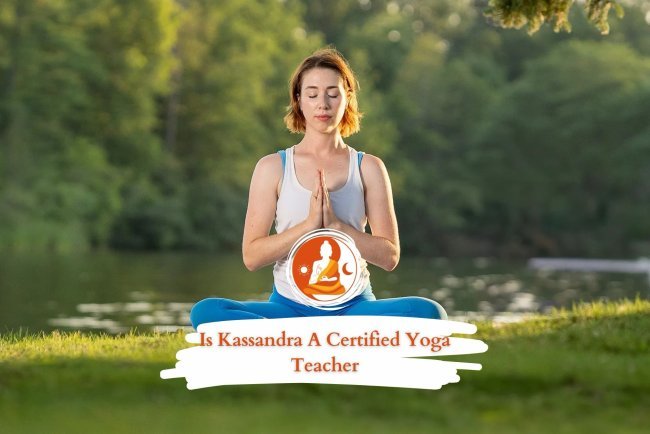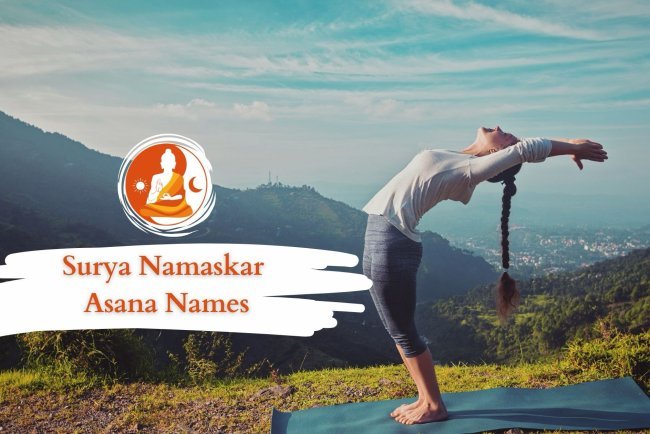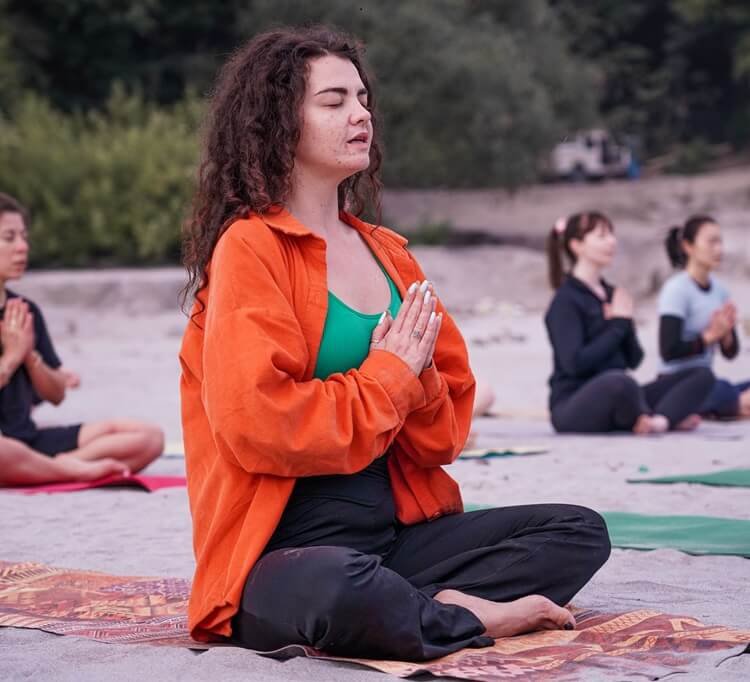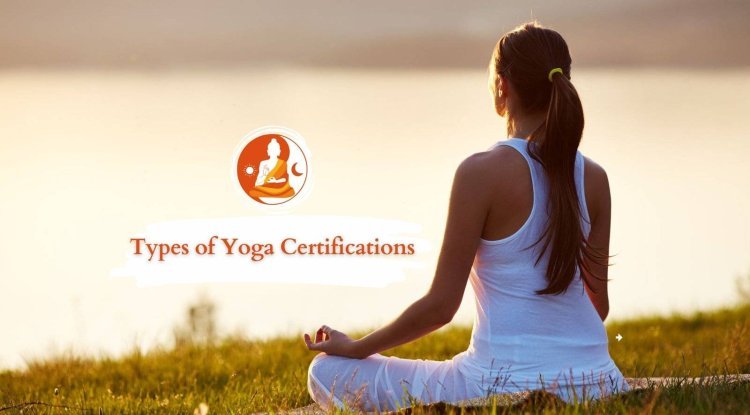How To Become A Certified Yoga Instructor? (7 Simple Steps)
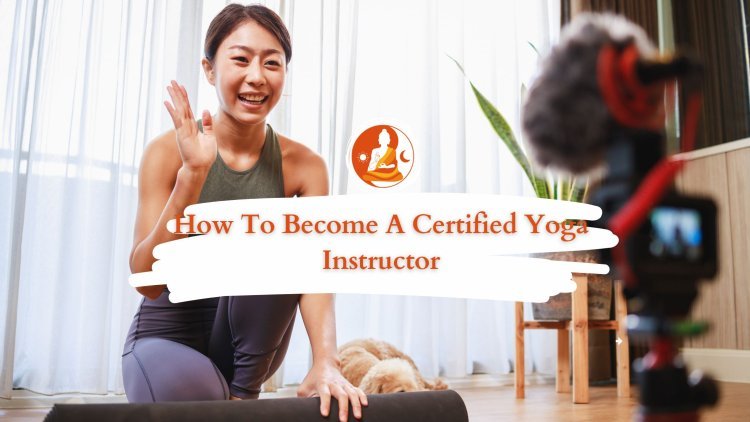
There is a greater need for trained yoga teachers due to the meteoric rise in yoga popularity in recent years. Obtaining a yoga instructor certification might be the ideal career choice for you if you have a strong enthusiasm for yoga and want to help others experience its many advantages.
From familiarizing yourself with the prerequisites to selecting an appropriate training program and beginning your teaching career, this all inclusive guide will lead you through the process of becoming a certified yoga instructor.
No matter where you are thinking of teaching yoga—in a studio, a gym, or even online—this article will provide you all the knowledge you need to get your yoga teaching career off the ground and help you become a competent and assured yoga teacher.
Understanding the Path to Yoga Instructor Certification
Before learning the yoga teacher certification process, you must comprehend the basic prerequisites. While there is no worldwide yoga certification organization, most respected studios and businesses choose teachers with a recognized training program.
The Importance of Proper Training
Being a yoga teacher requires more than simply postures. A complete training program includes:
- Yoga history and philosophy
- Physiology and anatomy
- Teaching method
- Adjustments and alignment
- Class planning, sequencing
- Business of yoga teaching
Proper training allows you to safely and successfully assist students through yoga practice while embracing its values. It gives you the ability to create meaningful and effective yoga experiences for your future students.
Selection of Certification Program
Consider these things while choosing a yoga teacher certification program:
- Accreditation: Find programs registered with Yoga Alliance, the biggest nonprofit yoga organization. This guarantees industry wide respect for your certification.
- Style of yoga: Find a Hatha, Vinyasa or Ashtanga curriculum that matches your teaching style. This can help you master your kind of teaching and attract pupils who like it.
- Format: Choose in person, online, or hybrid training. This option depends on your learning style and timetable, since each format offers benefits.
- Duration: Programmes vary from intense 3 4 week courses to part time programmes lasting months. Choose a length that suits your lifestyle and learning style.
- Vt: Assess program value and budget. A cheap solution may not be the best, but pricey programs do not guarantee excellence either.
- Instructor credentials: Check lead instructors' backgrounds. Reputable instructors may improve your learning experience.
- Depth of curriculum: A complete yoga curriculum should incorporate philosophy, anatomy, teaching methods, and business skills.
- Student support: Does the program provide mentoring, support, or resources for graduates? This is helpful when starting to teach.
Who Can Become a Yoga Instructor?
Anyone with dedication, passion, and a willingness to learn can become a yoga instructor. Unlike some professions that require specific physical abilities or academic backgrounds, yoga teaching is inclusive and adaptable to people from all walks of life.
1. Yoga Practitioners (Beginners to Advanced)
- You don’t need to be an expert in yoga to start your journey toward becoming a certified instructor.
- Many yoga teacher training programs (YTT) cater to both beginners and experienced practitioners, helping them build a strong foundation.
- A sincere commitment to learning and practicing regularly is more important than mastering complex asanas before enrolling in training.
2. Health & Wellness Enthusiasts
- If you are passionate about holistic health, mindfulness, and well-being, a career in yoga instruction can be a perfect fit.
- People from fields like nutrition, physiotherapy, fitness training, and holistic healing often integrate yoga into their professional practice.
3. Fitness Professionals & Athletes
- Personal trainers, athletes, and dancers often pursue yoga certification to enhance flexibility, strength, and mental focus.
- Yoga complements strength training, endurance sports, and dance, making it a valuable skill for fitness professionals.
4. Individuals Seeking a Career Change
- Many people transition from corporate jobs or stressful careers to become yoga teachers, seeking a more meaningful and fulfilling path.
- Yoga teaching allows flexibility in work schedules, self-employment opportunities, and a chance to create a balanced lifestyle.
5. Therapists, Healers & Counselors
- Yoga is deeply connected to mental and emotional well-being.
- Counselors, psychologists, and alternative healers (like Reiki practitioners) often incorporate yoga techniques into their practice.
- Specialized training in Yoga Therapy, Trauma-Informed Yoga, or Meditation Coaching can help professionals guide their clients toward healing.
6. Anyone Looking to Deepen Their Practice
- Some people don’t necessarily want to teach but enroll in yoga teacher training for self-growth and transformation.
- A YTT course offers in-depth knowledge of yoga philosophy, anatomy, meditation, and pranayama, which can enhance personal practice.
7. People of All Ages & Backgrounds
- Yoga teaching is not limited by age—many people start their journey in their 40s, 50s, or even later.
- Whether you are a student, stay-at-home parent, retiree, or traveler, yoga instruction is an accessible and rewarding career.
- The diversity in yoga teachers helps create inclusive spaces for students from different backgrounds.
Steps to Become a Yoga Instructor
Now that you understand the basics, let us dive into the specific steps to become a yoga instructor.
1. Develop Your Personal Practice
A solid personal yoga practice is a prerequisite to teaching others. Applicants to most training programs are required to have a minimum of one to two years of continuous practice. You will become a better instructor once you have this groundwork, which will allow you to appreciate the subtleties of various postures and sequences.
As you work on your own practice:
- Create a schedule where you do yoga at least three to four times each week.
- To deepen your comprehension, try out various yoga methods.
- Get a feel for diverse pedagogical approaches by taking courses from a range of professors.
- Maintain a yoga diary to document your development and new understandings.
- Incorporate breathing exercises and meditation into your routine.
The bedrock of your instruction is your own practice, therefore never forget that. Your ability to teach yoga with authenticity will increase in proportion to your level of knowledge and practice.
2. Research and Choose a Yoga Teacher Training Program
Yoga Teacher Training Courses (TTC) come in different levels, each designed to cater to different stages of a yogi’s journey. Whether you are a beginner looking to establish a foundation or an experienced practitioner aiming to deepen your expertise, there is a course suited for your needs.
The Different Levels of Yoga Teacher Training include:
- 100 Hour Yoga TTC (Foundational knowledge).
- 200 Hour Yoga TTC (Entry-level certification to start teaching).
- 300 Hour Yoga TTC (Advanced training for deeper practice).
- 500 Hour Yoga TTC (Comprehensive training for expert-level instructors)
Learn as much as you can about yoga teacher training courses when you have established a regular practice. Think about things like:
- Curriculum and material depth of the program
- Teacher credentials and years of classroom experience
- Feedback and testimonies from students
- Decisions about time and place
- Plans for cost and installment
- Resources and assistance after graduation.
Yoga Teacher Training (YTT) programs typically consist of 200 hours of instruction and are popular among those seeking to become yoga teachers. The Yoga Alliance recognizes this as the standard entry level certification that offers a thorough grounding in yoga teaching.
Do not be shy about contacting colleges with questions when studying programs. You may talk with alumni or attend educational seminars at many of them. As a result, you will have more information to work with while deciding on the software.
3. Complete Your Yoga Teacher Certification
You will learn the ins and outs of many facets of yoga throughout your training, such as:
- Yoga asana instruction and practice
- Methods of pranayama, or breathing exercises
- Mindfulness and meditation
- The ethics and philosophy of yoga
- Understanding the body mechanics in yoga
- Approaches to instruction and field experience
- Class scheduling and organization
- Practical tweaks and changes
- Yoga as a profession
You are in for a mental, emotional, and physical test as you embark on this rigorous learning journey. Welcome change and development as you go along the path.
When you are in the training:
- Give yourself up to the experience.
- When in doubt, ask questions and make sure you understand.
- Get as much experience as you can in the classroom.
- Seek out chances for practice and assistance from your other learners by connecting with them.
- To help you process life lessons and experiences, keep a notebook.
Keep in mind that being a yoga teacher is much more than simply learning the ropes; it is also about discovering who you are and finding your own style.
4. Register with Yoga Alliance (Optional but Recommended)
You have the option to become a Registered Yoga Teacher (RYT) with Yoga Alliance after your program is complete. Although it is not required, registering might get you additional teaching chances and boost your reputation.
To become a member of Yoga Alliance:
- Verify that Yoga Alliance has approved your training school.
- Fill out the application form online.
- Submit payment for registration.
- Accept the Yoga Alliance Code of Conduct as final and binding.
- Make sure you keep your registration current by completing the necessary continuing education hours.
Yoga Alliance registration gives you access to resources, networking events, and savings on yoga related goods and services; it also authorizes you to use the RYT designation (e.g., RYT 200).
5. Obtain Liability Insurance
Getting liability insurance is a must before you start teaching. In the event that you get injuries while attending lessons, this will safeguard you. Instructors practicing yoga are often asked by various studios to provide proof of insurance.
When deciding on a policy for liability:
- Seek for policies that are tailored to the needs of yoga teachers.
- Make sure the coverage is sufficient for the kind of lessons you give (e.g., online courses, individual lessons, studio classes)
- Evaluate several suppliers' quotes
- Verify whether the insurance covers both general and professional liability.
- Think about supplemental insurance policies that cover things like personal injury or property damage.
Always keep in mind that having yoga teacher liability insurance is a smart move for your profession and financial stability.
6. Gain Teaching Experience
Upon receiving your certification, begin instructing without delay. As a first step, many new teachers do:
- Treating loved ones to complimentary lessons
- Helping out local nonprofits and community centers
- Helping out at local studios as an assistant or substitute instructor
- Working as a fitness facility instructor
- Bringing lessons to parks or even business offices is a novel idea.
Gain self assurance and hone your teaching chops with this practical experience. When you begin instructing:
- Get input from both kids and more seasoned educators.
- To enhance your teaching, record yourself lecturing and watch the footage afterwards.
- Find what works best for your students by trying out various class styles and formats. Always be receptive to feedback that will help you improve as a teacher.
- In order to keep your motivation and genuine self expression levels high, stick to your own practice.
Never forget that you may grow as a teacher by taking advantage of every class you ever teach. As you work to improve your teaching abilities, remember to enjoy the ride and be kind with yourself.
7. Continue Your Education
Being a yoga teacher is all about never stopping to learn new things. Take into account:
- Learning more by going to seminars and workshops
- Getting more advanced certifications (such a 300 or 500 hour YTT)
- Having a focus on one particular area, such as yoga for pregnant women, children, or injury rehabilitation.
- Acquiring knowledge in complementary fields such as Ayurveda, mindfulness, or dietƒ
- Keeping up with the latest yoga literature and research
If you want to make your lessons interesting and provide your pupils additional value, continuing your education is a must. Furthermore, it aids in maintaining enthusiasm and enthusiasm for both your yoga practice and teaching.
Building Your Yoga Teaching Career
After certification and some teaching experience, grow your yoga teaching profession.
Finding Teaching Opportunities
Discover teaching opportunities at:
- Yoga centers
- Fitness centres and gyms
- Company wellness initiatives
- Wellness centers and retreats
- Internet platforms
- Parks and community centers
- Schools and universities
- Residences for seniors
- Rehabilitation centers
Connect with yoga instructors and studio owners to find opportunities. Do not be scared to propose yoga lessons to non yoga locations.
Developing Your Teaching Style
With practice, you will find your teaching style. This may involve:
- Blending yoga traditions
- Adding health habits like meditation and aromatherapy
- Targeting elders, athletes, prenatals
- Create signature sequences or class formats
- Bringing your personality and life experiences to teaching
Your genuine voice and attitude will set you out in a crowd. Remember that your teaching method will vary, so be flexible.
Marketing Yourself as a Yoga Instructor
Self promotion is essential in the digital era. Consider:
- Creating a professional website including your qualifications, classes, and teaching philosophy
- Building a social media presence to share your yoga experience and attract students
- Offering online courses or seminars to reach more people
- Cross promoting with wellness professionals
- Writing articles or making videos to teach and interest students
- Attending yoga festivals to network and acquire exposure
Your personal brand should represent your teaching philosophy and ideals. Be genuine and target your ideal pupils in your marketing.
Diversifying Your Yoga Career
As you progress in yoga, broaden your offerings:
- Hold yoga retreats or classes
- Creating online courses or videos
- Writing yoga related books or blogs
- Make yoga items
- Learn to train teachers
- Focus on corporate or private yoga
- Mix yoga with other practices like hiking or painting
Diversification may provide several revenue sources and keep your profession interesting.
Challenges and Rewards of Being a Yoga Instructor
Yoga instructors face obstacles and rewards like any other profession.
Challenges:
- Inconsistent revenue, particularly early on
- Regular practice and instruction need physical effort
- Managing personal practice and teaching
- Keeping motivated and avoiding burnout
- Yoga career business management
- Competing in a saturated market
- Adjusting to industry and student demands
To overcome these obstacles:
- Build a robust yoga teacher support system
- Take care of yourself and balance work and life
- Keep learning to remain motivated
- Create numerous revenue sources to balance your budget
- Master business basics to manage your career
Rewards:
- Teaching others yoga transforming power
- Personal development and learning
- Adjustable work schedule
- A supportive yoga community
- Career possibilities (conducting retreats, teacher training)
- Improve people health and well being
- Honoring your values and interests
- Building meaningful relationships with students and instructors
Yoga teachers who love it generally find the advantages outweigh the obstacles. Remember why you began this adventure and use that inspiration to get through tough moments.
Yoga Instructor Certification Options
When contemplating yoga certification, it is crucial to understand the numerous options:
200 Hour Yoga Teacher Training
This is the basic yoga teacher certification. Yoga philosophy, anatomy, teaching methods, and practical experience are covered. Most studios demand 200 hour instructor certification.
300 Hour Advanced Yoga Teacher Training
This seminar is for 200 hour graduates who wish to learn more. Advanced teaching methods, yoga treatment, and specialized studies are common.
500 Hour Yoga Teacher Training
A 500 hour certification may be earned by completing a 200 hour, 300 hour, or combination program. Advanced yoga certification shows knowledge and dedication to the practice and teaching.
Specialized Certifications
You may seek specialist certificates in areas like prenatal yoga, in addition to normal hour based certifications:
- Prenatal yoga
- Kid yoga
- Yin yoga
- Restful yoga
- Yoga treatment
- Aerial yoga
These specialised qualifications might help you stand out and target certain groups.
Online vs. In Person Yoga Teacher Training
You may train as a yoga teacher online or in person. There are pros and downsides to each:
Online Yoga Teacher Training
Advantages:
- Self paced study
- Often cheaper than in person trainings
- Access to international instructors
- No lodging or travel charges
Considerations:
- Limited hands on experience and rapid feedback
- Must be disciplined and driven
- Few trainee interactions in person
- May not fit classroom learners
In Person Yoga Teacher Training
Advantages:
- Immersion in hands on learning
- Interaction with instructors and classmates
- Immediate feedback on teaching and practice
- Strong community and support
Considerations:
- Often more expensive due to venue and accommodation costs
- Demands full time attention for weeks
- If unavailable locally, may need travel
- Limited scheduling freedom
When deciding between online and in person training, consider your learning style, budget, and living circumstances. Some programs offer hybrid alternatives that mix online and in person intensives for flexibility and hands on experience.
Continuing Education and Growth as a Yoga Instructor
The journey of becoming a yoga instructor does not end with certification. Continuing education is crucial for maintaining your skills, staying inspired, and growing your career. Here are some ways to continue your development:
Advanced Training Programs
Consider pursuing advanced certifications, such as:
- 300-hour or 500-hour yoga teacher training
- Specialized certifications in yoga therapy, prenatal yoga, or kids yoga
- Training in complementary practices like meditation or Ayurveda
Workshops and Seminars
Attend workshops and seminars on topics such as:
- Advanced asana practice
- Yoga philosophy and texts
- Anatomy and biomechanics
- Teaching methodology
- Business skills for yoga teachers
Self-Study and Practice
Dedicate time to your personal growth through:
- Regular self practice and exploration
- Reading yoga texts and modern research
- Journaling and self reflection
- Exploring other movement modalities to inform your yoga teaching
Mentorship and Peer Support
Seek guidance and support from:
- Experienced yoga teachers as mentors
- Peer groups for sharing experiences and challenges
- Online communities of yoga instructors
Teaching in Different Settings
Expand your experience by teaching in various environments:
- Different styles of yoga studios
- Gyms and fitness centers
- Corporate settings
- Retreats and festivals
- Online platforms
Attending Yoga Conferences and Retreats
Participate in larger yoga events to:
- Learn from renowned teachers
- Network with other yoga professionals
- Stay updated on industry trends and innovations
Remember, growth as a yoga instructor is an ongoing process. Stay curious, open minded, and committed to your personal and professional development.
The Impact of Technology on Yoga Instruction
As you navigate how to become a yoga instructor, it is important to consider the growing role of technology in the yoga industry:
Online Teaching Platforms
Platforms like Zoom, YouTube, and specialized yoga apps have made it possible to teach yoga to a global audience. Consider:
- Developing online classes and workshops
- Creating pre-recorded content for on demand viewing
- Utilizing social media platforms to reach and engage with students
Virtual Reality and Augmented Reality
Emerging technologies are creating new ways to experience yoga:
- VR yoga classes that provide immersive environments
- AR apps that offer real time pose corrections and guidance
Wearable Technology
Fitness trackers and smartwatches can provide data on:
- Heart rate and breathing patterns during practice
- Alignment and balance in poses
As a yoga instructor, staying informed about these technological advancements can help you enhance your teaching and reach a wider audience.
Bottom Lines
Obtaining a yoga instructor certification is an incredibly fulfilling process that demands commitment, ongoing education, and an authentic love for yoga. A rewarding job teaching others about the many advantages of yoga is within your reach if you follow the methods provided in this manual. Keep in mind that getting yoga certified is just the first step in a lifelong journey of professional development.
Continue to dedicate yourself to your yoga practice, seek out new knowledge, and be receptive to the life altering effects of yoga as you go down this road. Embrace the ups and downs of being a yoga teacher and be true to yourself and your passions.
Keep in mind that there is more to being a yoga teacher than just instructing postures, regardless of whether you want to teach in more conventional facilities, on more modern platforms, or carve out a special place for yourself in the yoga community. The key is to teach others what you have learned, build relationships with them, and assist them in achieving inner peace and harmony.
Keep in touch with your roots as a yoga teacher even as you develop professionally. Be led by your passion for yoga and your want to make a difference in the world. Becoming a yoga instructor is a rewarding profession that may change many people lives for the better if you put your mind, body, and spirit into it.
FAQs Section!
Depending on the school, a 200 hour yoga teacher training may usually be finished in three to five months. But getting there may take a year or more, and it does not even include building a personal practice.
Location, experience, and the kind of yoga studio one teaches at all have a significant impact on yoga instructor pay. Recent statistics show that yoga teachers in the US may expect to earn an average of $20 to $50 per class, with more opportunities for growth in areas such as individual lessons, seminars, and online classes.
While it is rare to find completely free yoga instructor certification programs, there are some low cost options available. Some studios offer work study programs where you can exchange your time and skills for reduced training costs. Additionally, some online platforms occasionally offer free introductory courses, though these typically do not lead to full certification.
Many yoga studios and fitness centers offer local yoga teacher training programs. To find options near you, try searching online for "yoga teacher certification near me" or contacting local yoga studios directly. Keep in mind that the availability of local programs may vary depending on your location.
After getting yoga certified, start by gaining teaching experience through volunteer work, assisting experienced teachers, or offering classes to friends and family. Build your network within the yoga community, create a strong personal brand, and consider specializing in a particular style or demographic. Continuously improve your skills through workshops and advanced training to stand out in the competitive yoga instruction field.
No, flexibility is not a prerequisite to becoming a yoga instructor. Yoga is about progress, not perfection, and flexibility improves with consistent practice. What matters most is your commitment to learning, teaching, and guiding others on their yoga journey, regardless of your starting point.
Yes. Many yoga instructors successfully teach online through platforms like YouTube, Zoom, and social media. Online yoga teaching allows you to reach a global audience, offer private sessions, or create pre-recorded courses. To succeed, focus on building an engaging presence, investing in good-quality video equipment, and marketing your classes effectively.
What's Your Reaction?








